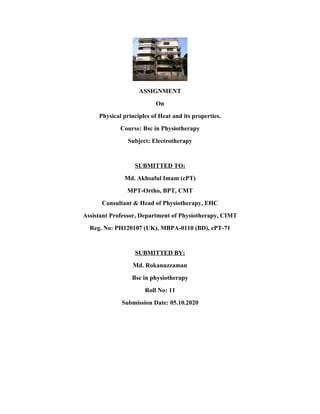
Heat
- 1. ASSIGNMENT On Physical principles of Heat and its properties. Course: Bsc in Physiotherapy Subject: Electrotherapy SUBMITTED TO: Md. Akhsaful Imam (cPT) MPT-Ortho, BPT, CMT Consultant & Head of Physiotherapy, EHC Assistant Professor, Department of Physiotherapy, CIMT Reg. No: PH120107 (UK), MBPA-0110 (BD), cPT-71 SUBMITTED BY: Md. Rokanuzzaman Bsc in physiotherapy Roll No: 11 Submission Date: 05.10.2020
- 2. Physical principle of Heat and it’s properties. Heat: It is a form of energy that increases the temperature of surrounding tissues or objects. Heat depends on the mass and energy of the particles. Heat flows from hot to cold until the heat is balanced which we call equilibrium. It is measured in calories, joules, or BTUs. Temperature: Temperature is a relative measure of the speed of the particles. Temperature is measured in degrees. The 2 main temperature scales are Celsius and Fahrenheit. Temperature and heat are not the same. Specific heat: The amount of energy needed to raise the temperature of 1 kg of a substance by 1 degree Celsius. It is the ability of a substance to absorb heat. This property can help identify substances. Example of Specific Heat: How much energy does it take to raisethe temperature of 2 kilograms of water by 3°C (specific heat of water is4,184 J/kg°C) Solution: 2 kilograms x 3°C = 6 kg°C 4,184 J/ kg°C x 6 kg°C = 25,104 J Types of Heat: A. According to the moisty- (1) Moist Heat (2) Dry Heat B. According to the Deep of Penetration- (1) Superficial Heat (2) Dry Heat Difference between Moist Heat and Dry Heat: Moist Heat Dry Heat The moist heat has water and system No use of water and system Sterilization with coagulation of protein Sterilization with oxidation This process is under pressure This process is on direct flame Process takes less time Process takes more time Moist heat is produce by boiling and autoclave Dry heat is produce by Flame and Incineration. Example: Hot water bath, Wax bath, Hydrotherapy packs, Contrast bath and steam bath. Example: IRR,SWD, MWD, Electric heating pads etc.
- 3. Difference between Supperficial Heat and Deep Heat. Features Superficial Heat Deep Heat Definition Heats the superficial tissue Heats the deep tissue Depth of penetration 3-5 mm Over an inch Physiological effects Reduce pain and muscle spasm Reduce inflammation, pathology of deep structure Example Heating pad, IRR, Wax therapy SWD, Ultrasound Process of transmission: Heat can be transmission by following three ways- 1. Conduction 2. Convection 3. Radiation Conduction: When heat is transmitted in a component from the area of high temperature to the area of low temperature but hot particle do not change their place, the process is called conduction. Process of conduction: If one end of a solid metal rod is heated, the energy added cause an increase vibration of the molecules and heat is transmitted to them and in this way, heat is conducted along the bar from the area of high temperature to areas of lower temperature. Convection: It takes place in a liquid or gas. If one part of the fluid is heated, the kinetic energy of molecules in that part is increased, they move further apart and this part becomes less dense. Consequently, less dense part goes upwards and more dense part comes downwards to take its place. A change of place of liquid and/or gas occurs and finally, all contents are heated evenly. Radiation: Heat may be transmitted by infra-red electromagnetic radiation. The heating of certain atoms causes and electron to move to a higher energy electron shell, The energy is released as a pulse of infra-red electromagnetic energy. Latent Heat: A specific amount of heat required to change the state of a particular substance. It may either from solid to liquid or liquid to gas or vice versa. The heat is called latent heat. In this situation, the temperature remains same. Latent Heat of fusion: It is the amount of heat which is required to change the state of a substance from solid into liquid. As for Example- in case of water, 1 gram of Ice at 0⁰C requires 336 joules of energy to convert into 1 gram water at 0⁰C.
- 4. Latent heat of vaporization: It is the amount of heat which is required to change the state of a substance from liquid into gas. As for Example- in case of water, 1 gram water at 100⁰C requires 2268 joules of energy to convert into 1 gram steam at 100⁰C. Properties of Heat: Heat is a form of energy and not a physical substance. Heat has no mass. Heat can move from one place to another in different ways: The measure of how much heat is needed to cause some change in temperature for a material is the specific heat capacity of the material. Physiological effects of heat : Increase metabolism Increase the extensibility of collagen tissues. Decreasing joint stiffness. Reducing pain Relieving muscle spasm Reducing inflammation Reducing oedema. Reducing aids in the post-acute phase of healing Increase blood flow Increase nerve stimulation.